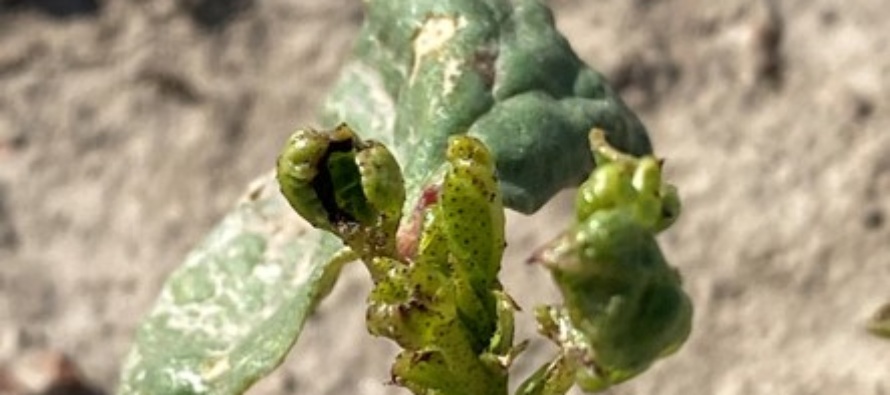Foliar Thrips Control Options in Cotton: Pros and Cons

Related Articles
- Fertilizing Cotton with Poultry Litter 5
- Mississippi Cotton Insect Situation of 2010: A Look Back 3
- Bayer CropScience-O.A. Cleveland Weekly Cotton Commentary 0
Latest Tweets
Thrips pressure to date has been a mixed bag. Some areas have reported treatable numbers, while in other areas seed treatments have held well. Going forward, should you need to treat thrips with a foliar insecticide there are a few things to consider.
First, we only have a few options. Acephate, Bidrin, Dimethoate, Intrepid Edge, and Radiant. Pyrethroids provide little to no control in all the University testing across the Mid-South. Below are a few Pros and Cons of each of these.
Acephate: Rates applied are typically 0.22-0.33 lbs/acre. Acephate has been a cheap reliable product in the past. Acephate is by far the least likely to cause crop injury of the three organophosphate products when mixed with herbicides (compared to Bidrin and Dimethoate). However, in the last couple years when applied as a foliar option, control has been a little less consistent. There is some evidence out of TN that we could be on the verge of possible resistance to this compound. It does not mean it will not work everywhere, but it does possibly explain some of the erratic performance we have witnessed over the last couple years in some locations. Additionally, out of all of our foliar thrips insecticides, acephate is the least rainfast of the group. In times of high probability of rain, acephate would be a poor choice and would require an 8-12 hour rain free period following application to achieve maximum results. Also, acephate is notorious for flaring secondary pests such as aphids and spider mites.
Bidrin: Rate applied is 3.2 oz/acre. Higher rates cannot be used prior to bloom. Bidrin has performed well against thrips in most University trials over the years. This product is a little more costly, but is very rainfast and good choice when rain is in the forecast. Bidrin also is less likely to flare secondary pest such as spider mites or aphids. In fact, it was once used for aphid control prior to resistance. In some areas it still provides suppression of aphids but would not be an early season choice for aphids, because of past problems with resistance and the thrips rate is low for aphids. Between the 3 organophosphates we recommend for thrips, it falls in the middle between acephate and dimethoate for crop injury when tank mixed with herbicides.
Dimethoate: Rate 6.4 oz/acre. Dimethoate is an old stand by that’s been around a long time. It has performed fairly well in University trials over the years and is fairly rainfast as well. It is a very cost effective product, but out of the three organophosphates is most likely to cause crop injury when tank mixed with herbicides. Dimethoate typically is not bad about flaring secondary pest.
Radiant: Rate 1.5 oz/acre. Radiant works well on thrips, including western flower thrips (we mostly deal with tobacco thrips in MS), but mixing a surfactant is a must. We discovered this years ago. Radiant has traditionally been known as a caterpillar pest product, but we have been impressed with the level of thrips activity in our trials. The likelihood of flaring secondary pests is almost zero. It is a little more costly and rainfast shortly after application. It is almost completely safe from a crop injury standpoint when mixing with herbicides.
Intrepid Edge: Rate 3 oz/acre. Most folks are familiar with Intrepid Edge for controlling caterpillar pests in soybean and cotton. It is a premix of Intrepid and Radiant. It performs well on thrips, but it is the Radiant pulling the load. It has all the same attributes as Radiant, but is actually cheaper. Surfactants are not a requirement with this product, but I would highly recommend. With both Radiant and Intrepid Edge, although we have very little if any real data, I would suspect we would additionally get some level of cutworm control although the thrips rates are a little low.
Thrips and Yield:
We have conducted numerous thrips trials across the Mid-South region over the years. Across all the trials in the region, we have seen about 115 lb/lint acre yield response when thrips are controlled compared to no control at all (including seed treatment). In our testing, we additionally rate thrips damage on a scale of 1-5, where 1 is no damage and 5 is severe damage. We typically do not see yield loss until we exceed damage ratings of 3 on the scale and they do not become consistent until we see ratings of 4 and above. Below is the scale we use to rate damage in case your wondering how your field damage or lack there of would line up with our results.

Also we get asked a lot about what can be mixed with the Xtend and Enlist cotton herbicides. We went through the tank mix partner websites and listed those that can be mixed with these herbicides according the their labels. The tank mix partner websites for each of these herbicides are updated very frequently so this is intended to just be a quick reference guide. Also, It is important to remember that there are only certain formulations of these insecticides that may be actually labeled. Additionally, some require certain drift reducing agents to be mixed. It is important that you check these sites for the product you wish to apply for additional labeling language. This is only intended as a quick reference guide.
Click the following links to go the tank mix web sites of each product.





Let me tell You a sad story ! There are no comments yet, but You can be first one to comment this article.
Write a comment